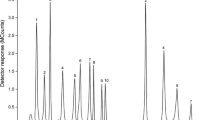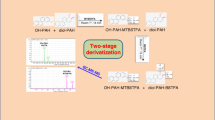Abstract
4,4′-Methylenediphenyldiisocyanate (MDI), toluenediisocyanate (2,4-TDI and 2,6-TDI), and 1,6′-hexamethylenediisocyanate (HDI) are all commonly used in the production of polyurethane-containing materials in different application areas. Workers exposed occupationally to these compounds may develop sensitization with the potential to lead to asthma. Isocyanates are metabolized in vivo by conjugation to macromolecules and/or by acetylation prior to being eliminated in urine. The hydrolysis of urine samples releases free amine compounds from these metabolites as biomarkers of exposure, specific to each parent isocyanate: 4,4′-methylenedianiline (MDA), toluenediamine (2,4-TDA and 2,6-TDA), and hexamethylenediamine (HDA). To address the need for a validated method that could be used for the simultaneous determination of biomarkers of aliphatic and aromatic isocyanates to monitor occupational exposure based on recommended thresholds, we have developed an UPLC-MS/MS method for the quantitation of MDA, TDA isomers, and HDA following acid hydrolysis, solid-phase extraction, and derivatization of urine samples. Free amine compounds were derivatized with acetic anhydride to augment chromatographic retention and signal intensity. The method was developed considering the biological guidance value (BGV) of MDA at 10 μg L−1, and biological exposure indices (BEI) of TDA isomers and HDA at 5 μg g−1 and 15 μg g−1 creatinine, respectively. Limits of detection allowed monitoring down to 6% of BGV/BEI, with precision within 8%. The accuracy and reliability of the method were assessed using inter-laboratory reference samples and deemed acceptable based on three rounds of measurements. This novel method has therefore been proven as useful for occupational safety and health assessments.

Graphical Abstract




Similar content being viewed by others
References
Cocker J. Biological monitoring for isocyanates. Occup Med (Lond). 2007;57(6):391–3. https://doi.org/10.1093/occmed/kql148.
European Commission. Methylenediphenyl diisocyanate (MDI): Institute for Health and Consumer Protection2005.
Brorson T, Skarping G, Sango C. Biological monitoring of isocyanates and related amines. IV. 2,4- and 2,6-toluenediamine in hydrolysed plasma and urine after test-chamber exposure of humans to 2,4- and 2,6-toluene diisocyanate. Int Arch Occup Environ Health. 1991;63(4):253–9. https://doi.org/10.1007/bf00386374.
Gaines LG, Fent KW, Flack SL, Thomasen JM, Ball LM, Richardson DB, et al. Urine 1,6-hexamethylene diamine (HDA) levels among workers exposed to 1,6-hexamethylene diisocyanate (HDI). Ann Occup Hyg. 2010;54(6):678–91. https://doi.org/10.1093/annhyg/meq041.
Brorson T, Skarping G, Nielsen J. Biological monitoring of isocyanates and related amines. II. Test chamber exposure of humans to 1,6-hexamethylene diisocyanate (HDI). Int Arch Occup Environ Health. 1990;62(5):385–9. https://doi.org/10.1007/bf00381369.
Kreis K, Aumann-Suslin I, Ludeke A, Wegewitz U, Zeidler J. Graf von der Schulenburg JM. Costs of isocyanate-related occupational diseases: a systematic review. J Occup Environ Hyg. 2019;16(7):446–66. https://doi.org/10.1080/15459624.2019.1609005.
Sekizawa J, Greenberg MM. Diphenylmethane diisocyanate (MDI). Geneva: World Health Organization2000 Contract No.: 27.
Thorne PS, Hillebrand JA, Lewis GR, Karol MH. Contact sensitivity by diisocyanates: potencies and cross-reactivities. Toxicol Appl Pharmacol. 1987;87(1):155–65. https://doi.org/10.1016/0041-008x(87)90093-7.
Rosenberg C, Nikkila K, Henriks-Eckerman ML, Peltonen K, Engstrorm K. Biological monitoring of aromatic diisocyanates in workers exposed to thermal degradation products of polyurethanes. J Environ Monit. 2002;4(5):711–6. https://doi.org/10.1039/b206340a.
Marand A, Karlsson D, Dalene M, Skarping G. Determination of amines as pentafluoropropionic acid anhydride derivatives in biological samples using liquid chromatography and tandem mass spectrometry. Analyst. 2004;129(6):522–8. https://doi.org/10.1039/b403439b.
Cocker J. Biological monitoring for isocyanates. Ann Occup Hyg. 2011;55(2):127–31. https://doi.org/10.1093/annhyg/meq083.
Jones K, Johnson PD, Baldwin PEJ, Coldwell M, Cooke J, Keen C, et al. Exposure to diisocyanates and their corresponding diamines in seven different workplaces. Ann Work Expo Health. 2017;61(3):383–93. https://doi.org/10.1093/annweh/wxx006.
Creely KS, Hughson GW, Cocker J, Jones K. Assessing isocyanate exposures in polyurethane industry sectors using biological and air monitoring methods. Ann Occup Hyg. 2006;50(6):609–21. https://doi.org/10.1093/annhyg/mel024.
Bello A, Xue Y, Gore R, Woskie S, Bello D. Assessment and control of exposures to polymeric methylene diphenyl diisocyanate (pMDI) in spray polyurethane foam applicators. Int J Hyg Environ Health. 2019;222(5):804–15. https://doi.org/10.1016/j.ijheh.2019.04.014.
Bhandari D, Ruhl J, Murphy A, McGahee E, Chambers D, Blount BC. Isotope dilution UPLC-APCI-MS/MS method for the quantitative measurement of aromatic diamines in human urine: biomarkers of diisocyanate exposure. Anal Chem. 2016;88(21):10687–92. https://doi.org/10.1021/acs.analchem.6b03191.
Sabbioni G, Dongari N, Kumar A. Determination of a new biomarker in subjects exposed to 4,4'-methylenediphenyl diisocyanate. Biomarkers. 2010;15(6):508–15. https://doi.org/10.3109/1354750X.2010.490880.
Bolognesi C, Baur X, Marczynski B, Norppa H, Sepai O, Sabbioni G. Carcinogenic risk of toluene diisocyanate and 4,4'-methylenediphenyl diisocyanate: epidemiological and experimental evidence. Crit Rev Toxicol. 2001;31(6):737–72. https://doi.org/10.1080/20014091111974.
Gledhill A, Wake A, Hext P, Leibold E, Shiotsuka R. Absorption, distribution, metabolism and excretion of an inhalation dose of [14C] 4,4'-methylenediphenyl diisocyanate in the male rat. Xenobiotica. 2005;35(3):273–92. https://doi.org/10.1080/00498250500057591.
DFG. List of MAK and BAT values 2016: Permanent Senate Commission for the Investigation of Health Hazards of Chemical Compounds in the Work Area2016.
ACGIH. Threshold limit values for chemical substances and physical agents and biological exposure indices. Cincinnati: OH; 2017.
Bhandari D, Bowman BA, Patel AB, Chambers DM, De Jesus VR, Blount BC. UPLC-ESI-MS/MS method for the quantitative measurement of aliphatic diamines, trimethylamine N-oxide, and beta-methylamino-l-alanine in human urine. J Chromatogr B Anal Technol Biomed Life Sci. 2018;1083:86–92. https://doi.org/10.1016/j.jchromb.2018.02.043.
Sakai T, Morita Y, Kim Y, Tao YX. LC-MS determination of urinary toluenediamine in workers exposed to toluene diisocyanate. Toxicol Lett. 2002;134(1-3):259–64.
Skarping G, Dalene M, Brunmark P. Liquid-chromatography and mass-spectrometry determination of aromatic-amines in hydrolyzed urine from workers exposed to thermal-degradation products of polyurethane. Chromatographia. 1994;39(9-10):619–23. https://doi.org/10.1007/Bf02268290.
Cocker JG, W. and Wilson, HK. Assessment of occupational exposure to 4,4'-diaminophenylmethane (methylene dianiline) by gas chromatography-mas spectrometry analysis of urine. Br J Ind Med 1986;43(9):620-625.
Sauve JF, Levesque M, Huard M, Drolet D, Lavoue J, Tardif R, et al. Creatinine and specific gravity normalization in biological monitoring of occupational exposures. J Occup Environ Hyg. 2015;12(2):123–9. https://doi.org/10.1080/15459624.2014.955179.
Lepine M, Sleno L, Lesage J, Gagne S. A validated liquid chromatography/tandem mass spectrometry method for 4,4'-methylenedianiline quantitation in human urine as a measure of 4,4'-methylene diphenyl diisocyanate exposure. Rapid Commun Mass Spectrom. 2019;33(6):600–6. https://doi.org/10.1002/rcm.8380.
Baker GB, Coutts RT, Holt A. Derivatization with acetic anhydride: applications to the analysis of biogenic amines and psychiatric drugs by gas chromatography and mass spectrometry. J Pharmacol Toxicol Methods. 1994;31(3):141–8. https://doi.org/10.1016/1056-8719(94)90076-0.
DFG. 4,4′-Methylene diphenyl diisocyanate (MDI) [ 101-68-8] and “polymeric” MDI (PMDI) [ 9016-87-9] [MAK Value Documentation, 2008]. The MAK-Collection for Occupational Health and Safety. Wiley-VCH Verlag GmbH & Co KGaA; 2015.
Sepai O, Henschler D, Sabbioni G. Albumin adducts, hemoglobin adducts and urinary metabolites in workers exposed to 4,4'-methylenediphenyl diisocyanate. Carcinogenesis. 1995;16(10):2583–7. https://doi.org/10.1093/carcin/16.10.2583.
Author information
Authors and Affiliations
Corresponding authors
Ethics declarations
Conflict of interest
The authors declare that they have no conflict of interest.
Additional information
Publisher’s note
Springer Nature remains neutral with regard to jurisdictional claims in published maps and institutional affiliations.
Rights and permissions
About this article
Cite this article
Lépine, M., Sleno, L., Lesage, J. et al. A validated UPLC-MS/MS method for the determination of aliphatic and aromatic isocyanate exposure in human urine. Anal Bioanal Chem 412, 753–762 (2020). https://doi.org/10.1007/s00216-019-02295-y
Received:
Revised:
Accepted:
Published:
Issue Date:
DOI: https://doi.org/10.1007/s00216-019-02295-y




